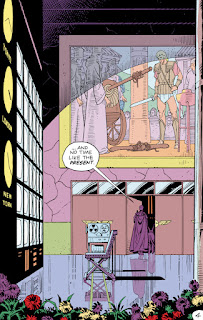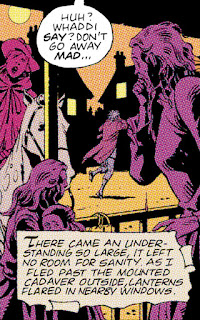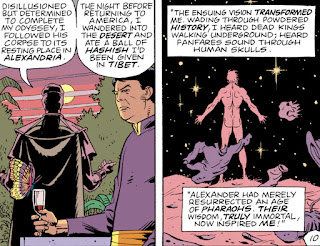Here it is. I am finally almost done with my page-by-page review of Watchmen. And this isn’t the end — it’s only the beginning of my grander goal of looking at all the adaptations of Watchmen to see how closely they fit what I perceived to be Alan Moore’s original vision.
This issue has one of the most powerful openings in all comics. Six silent splash pages depicting grotesque horror.
Gibbons didn’t do any official two-page spreads in this series. But he came frustratingly close a couple of times. I just want to go in and tweak that tentacle ever so slightly to make it line up.
It was a little convenient to have all these minor characters at the same place at midnight. But it does make for a satisfying, albeit macabre finale for them.
At the center of everything is poor Bernard and Bernie — the man who read all the newspapers and the boy who read all the comic books. They, like most of the other victims of this attack, are some of the very few truly likable characters of this story. Which helps give this tragedy some real stakes.
I had previously wondered how long it took Dr. Manhattan to teleport to and from Mars. Perhaps it was usually instantaneous, but the story doesn’t specifically say. I wish Dr. Manhattan would have said something like he wanted to go back two days ago. Regardless, the tachyons somehow caused him to skip ahead in time a bit — lost in teleportation limbo from Mars for 48 hours. I can only presume that was a happy accident of Adrian’s plan.
For the first time in years, Dr. Manhattan feels the sensation of surprise. And he gets so excited by this, it takes him a minute to acknowledge Laurie’s suffering — again.
Adrian won’t stop belittling Rorschach and I am here for it!
My biggest frustration with Watchmen. If young Robert Deschaines really was the key, then why didn’t we ever get to see him?
For the first — and only — time in this story, Adrian is legitimately afraid. He does fear for his life, but I think he’s also worried that Dr. Manhattan’s arrival means that he also prevented the attack in New York.
Dave Gibbons devotes a lot of space to Laurie making her way into Adrian’s lair. This highlights her continued isolation and unfortunate role as the most forgettable character in this cast. But I also think Gibbons and Moore were trying to build up the tension of Laurie bringing a gun to the final confrontation. Personally, I think that bit fell flat.
It’s quite impressive how Adrian’s preparation (and paranoia) led to him recreating the device that turned Jon Osterman into Dr. Manhattan. It’s also quite lucky that Adrian was able to put Dr. Manhattan in range of this machine.
This was unnecessary. It feels like Alan Moore saw what he concerned a plot hole in Adrian’s staged assassination and decided to justify it after the fact. But I never worried about the possibility of the gunman hitting Adrian first instead of the secretary. If Adrian knew when and where the hitman would be, he would have had ample time to protect himself. I also worry that having him “catch” a bullet makes him too powerful. I thought the only one here with real superpowers was Dr. Manhattan. Adrian’s already the smartest and the best fighter. Does he really need another physical ability outside the realm of human feasibility?
I do love this line, though. Adrian has just pulled off his decades-long scheme, easily bested Nite Owl and Rorschach in hand-to-hand combat, obliterated the most powerful being in the universe, and even caught a bullet. He has no time for Dan’s chivalry.
Dr. Manhattan hasn’t been in a real fight in a long, long time. Yes, this is a dramatic act of intimidation. But it’s not very efficient. Obviously he wanted to question Adrian before killing him, but he wastes time trying to belittle him. I guess it’s just a petty act from the allegedly emotionless being.
Hey, Jon! That termite just pulled off the greatest conspiracy of all time right under your nose! (Man, I’m really becoming an Adrian cheerleader here …)
Even though we knew Adrian’s plan worked, he had no confirmation of it until he turned on his TVs. And for the first time in this story, he permits himself to celebrate like a normal human. It’s a rather unsettling sight to see him exhibit so much emotion, especially when one considers what, exactly, he’s cheering.
I am stunned, absolutely gobsmacked that this conversation only lasted three panels. I’m not saying it’s wrong to have these characters ultimately come to these conclusions, but they needed to have a longer conversation about it! This is the story that spent an entire issue teaching Dr. Manhattan the value of life. But this incredibly complex moral problem is condensed to a few quick lines?
It’s a little surprising that Adrian didn’t kill his “guests,” considering how he coldly murdered his most loyal servants to prevent the slim possibility that one of them would expose him in the future. I suppose Adrian initially wanted someone to gloat to. And once Dr. Manhattan showed up, he probably assumed that he wouldn’t let anything bad to happen to Laurie (and maybe even Dan). As for Rorschach, well, it’s refreshing to see Adrian’s finally realized he’s not much of a threat. I’ll still maintain that Adrian needn’t have bothered conspiring to throw Rorschach in jail.

This issue has so much to get through — so many loose ends to tie up and deep conversations to have — that the pacing sometimes feels a bit jarring. Especially this moment. Adrian abruptly leaves his “guests,” Dr. Manhattan leaves to kill Rorschach, and Dan and Laurie spontaneously start making love. It’s an absolutely insane response to this moment, but I guess that’s sort of the point. How would people to a situation like this? Especially Laurie, who still hasn’t had time to reconcile with the revelation of her true father?

Rorschach may be an idiot, but he’s not stupid. (Wait, does that even mean anything?) He knows he’ll never be able to find his way back to the Owlship, get it working again, and fly it all the way back to New York. But he has to try because he can’t conceive of anything else to do. Yes, he’s made a bunch of compromises during his life, but he doesn’t count those because they were born of the cognitive dissonance in his own brain. It’s when someone else asks him to compromise that makes him dig in his heels and double down on his illusions. And finally, at the very end, he’ll pay for this obstinance with his life.
This is not the portrait of a courageous martyr fighting for his beliefs until the end. This is a terrified, defeated, sorry excuse for a man. He’s not daring Dr. Manhattan to show some backbone. He’s begging Jon to save him the indignity of freezing to death on the Antarctic plains. He’s pleading to be saved from himself.

Dr. Manhattan’s actions are rather perplexing at the end of this story. It’s almost like a new, more assertive Dr. Manhattan was born after Adrian “killed” him. Does he still see himself as a puppet bound to the predetermined future? Or does he now finally realize that he possesses the power to influence the world around him? After he reformed himself, he led the brief, yet crucial discussion on accepting Adrian’s plan. He then committed what can best be described as a mercy killing of Rorschach, before walking in on Laurie and Dan sleeping in each other’s arms. He grants a smile of approval before oddly choosing to walk across the water of Adrian’s swimming pool. Was this an unconscious act of one considering taking on the role of a god? Or was he “testing the waters” of divinity?

In one of my favorite parts of the story, Adrian allows himself to be vulnerable in private with Dr. Manhattan. He reveals the pressing doubt he surely felt during every step of his massive plan. Adrian begs the seer to tell him he did the right thing, but he only gets vague answers in reply. Dr. Manhattan is leaving this world to create a new one. Is that because this world is destined to become a utopia that won’t need his services anymore? Or is it now tainted beyond redemption? The doctor coyly will never say.

From what I understand, DC made a deal with Moore to give him back the rights to Watchmen as soon as they stopped publishing Watchmen stories. But DC quickly learned this is a cash cow that will never dry out. Every few years, they release a new collection of the core story in hard cover, paperback, oversized omnibus format, new coloring, no coloring at all, and on and on. Then there’s the adaptations, including the movie, the prequel comics, the sequel TV series, and many other little things in between. No, Watchmen will never end.


I’m a little surprised that this issue — overfilling with content it can’t fit — would devote three full pages to Sally. I guess Moore really wanted to get in that “you look like a waitress” line (which is a great line, by the way). But seriously, I do understand the need to have some closure to this relationship. Laurie’s forgiveness comes quickly and easily, which is hard to imagine happening without the apocalyptic event putting things in perspective. Maybe she would have eventually gotten there on her own, but I think it would have taken longer.

The story began with Eddie Blake dying on the street. It ends with his portrait being kissed by the woman he attempted to rape, then later fathered a child with. Sally’s relationship with Eddie is so complex and messy and confusing — a wonderful encapsulation of this entire story. Bad people don’t always do bad things. Good people don’t always do good things. We sometimes grow to love the people we hate. And even switch back and forth several times through our lives. Nothing is as neat and tidy as we’d like. And that’s part of the power of this story. It dared to feature a main cast of unlikable characters. It didn’t shy away from an unsatisfactory ending. Giving in to those conventional tropes would have robbed the readers the chance to ponder the unanswerable questions Moore asked.

I consider the last two pages an epilogue. It’s been some time since Adrian’s fake invasion — probably a year or more. New York is cleaned and repaired. There are new electric chargers on the streets and restaurants bizarrely selling American and Russian cuisine. But through all that upheaval, the radical New Frontiersman survived with the same old abusive editor and poor little Seymour who never thought to get a new job. But it’s a good thing he stuck around — he’s about to stumble upon the biggest story of the century.
What a glorious final panel. Alan Moore, Dave Gibbons and John Higgins have told their story. And now they leave it in our hands. For better and worse, “our” includes DC Comics, which has unceasingly sought to profit off this story. The slew of adaptations and reprintings isn’t necessarily a bad thing — even at their worst, terrible sequels can’t tarnish the image of a masterpiece.









































































